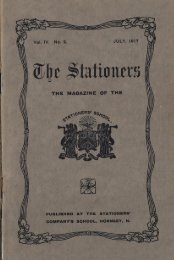You also want an ePaper? Increase the reach of your titles
YUMPU automatically turns print PDFs into web optimized ePapers that Google loves.
T h e O l d S t a t i o n e r - N o 9 0
cut off the bridgehead. The Commando
regiment was withdrawn in September of
that year returning to the UK to reform
and re-equip. Owen returned to combat in
the Commando attack on the fortified
island of Walcheren to remove the dug-in
German forces preventing Allied access to
the port of Antwerp.
Within Overlord, No.4 Commando took on
an assault role. They were the first
Commandos to hit the beaches on D-Day.
Having disembarked from their landing
craft Princess Astrid and Maid of Orleans,
with 500 men, they landed on Queen Red
beach to find 8 Infantry Brigade pinned
down by enemy fire. In the mêlée that
followed the Commandos suffered forty
casualties including the Commander,
Lieutenant-Colonel Dawson. He handed
over his command to Menday. The
Commando pushed forward, breaking out
onto the coastal road and set off for
Ouistreham, led by Nos.1 and 8 (French)
troops of No.10 (IA) Commando. No.4
Commando joined the others at Hauger and
dug in between Sallanelles and Le Plein.
Continuous enemy pressure on the
Commando forestalled efforts to send a
relief force to No.45 (RM) Commando,
and by 8th June Nos.3 and 6 were both
forced to mount counter-attacks during
the day. By the evening, No.45 managed to
break out and reach No.4's lines. No.4
Commando was withdrawn, for some
much needed rest, and replaced by the
12th Parachute Battalion.
On 1st August, Mills-Roberts was ordered
to seize and hold a section of high ground
by dawn the following day. This was in
support of a further advance to Dozule by
6th Airborne Division. No.4 Commando
led with Nos.3, 45 and 6 following behind.
The Brigade infiltrated through the
German line and reached the objective
before the Germans realized it. There were
four counter-attacks throughout the day
but the brigade held firm.
No.1 SS Brigade landed at Southampton
and Gosport on 8-9 September, and No.4
Commando moved to Shanklin, Isle of
Wight to retrain, reequip and rest. During
this period new volunteers were recruited
and trained. No.4 Commando was later
sent back to the continent to take over
from the shattered No.46 (RM)
Commando, which was down to a strength
of only 200 men.
Walcheren - Nov 1 to 8 1944
The fortified island of Walcheren guarded
the approaches to Antwerp some 25 miles
up the Scheldt. The use of Antwerp
harbour was needed to supply the
advancing Allied forces, but first of all the
German's had to be removed from
Walcheren.
In the assault on the island No.4
Commando was tasked with crossing from
Breskens and attacking Flushing. This was
to be done in concert with Nos.1 and 8
(French) Troops and supported by 155
Infantry Brigade. No.4 Commando landed
at 0545 hours and attacked Flushing after
having some trouble finding a suitable
landing spot. By 1600 hours they had
reached most of its objectives, and
consolidated, continuing the battle the
next day. Typhoons attacked enemy
positions and after a prolonged battle the
Germans made a bolt for it suffering
several casualties from No.5 (French)
troop.
No.4 handed over to 155 Brigade two days
later and embarked by LVT to assault two
gun batteries, W3 and W4, north-west of
Flushing, They landed in a gap in the dyke
but the attack was postponed to give the
Commando the rest it needed after 40
hours of continuous activity. The attack
was later cancelled when No.47 (RM)
Commando broke through. Now
concentrated at Zouteland, there was a
pause for re-supply. The next mission, in
conjunction with No. 48, was to clear the
Overduin woods, and then push onto
Vrouwenpolder to engage remaining
enemy resistance.
As the front moved westward No.4
Commando were made responsible for the
Walcheren area. After a period of refitting
and rest at Ostend they spent the remainder
of the war guarding the approaches to
Antwerp. Visit Walcheren for a full
account of the action.
No.4 Commando was wound down in
Germany having had a strength of only
180 men by June 1945. It was disbanded in
mid-November 1945.
After returning from North Africa, No. 6
Commando became part of the 1st Special
Service Brigade, commanded by Brigadier
The Lord Lovat. The grouping of the
commandos into brigades underneath the
divisional-sized Special Service Group
headquarters was part of the general
reorganisation that took place in late 1943
as the evolution of their role from raiding
to assault infantry was formalised. This
saw a change in the individual unit
establishments, with the addition of
organic transport assets, as well as an
increase in the allocation of indirect and
direct fire support weapons at commando
level. Further support units were added at
brigade level, including administration,
transport, logistics and signals.
On D-Day the 1st Special Service Brigade
was tasked with landing behind the 8th
Infantry Brigade, capturing the port of
Ouistreham and linking up with the 6th
Airborne Division on the eastern flank of
Sword Beach, where they were holding the
high ground near La Plein and the bridges
over the River Orne and Caen Canal. No.
6 Commando, with Lovat's brigade
headquarters, came ashore at the Queen
Red sector of Sword Beach, near La
Breche, at 8:40 am on 6 June 1944.
No. 6 Commando led the brigade from
the beach. Moving through a swamp that
briefly slowed their progress, the
commandos began to come up against the
German defences that had not been
destroyed by the naval bombardment.
Where possible they attempted an indirect
approach, penetrating the defences using
infiltration tactics. However, as they
advanced towards bridges that had been
captured by the paratroopers earlier in the
day, they assaulted four pillboxes as well as
an artillery battery that had been firing on
the landing beaches.
In the end it took the commando threeand-a-half
hours to advance the 6.5 miles
(10.5 km) to the bridges, with the lead
elements, mounted on bicycles, linking up
with glider borne troops from D Company,
2nd Battalion, Oxford and Buckinghamshire
Light Infantry under Major John Howard.
After effecting the link up, the commandos
joined with paratroops from the 9th
Battalion, The Parachute Regiment in an
attack on the village of La Plein, before
digging in to begin defending against
possible counterattack. By the end of the
day, No. 6 Commando had suffered three
killed and 32 wounded.
In the week that followed the brigade
undertook defensive duties as the Germans
attempted to apply pressure on the
beachhead by infiltrating the defensive
positions on the eastern flank. On 12 June,
the airborne troops launched an attack on
the village of Breville from where German
artillery had been shelling them during the
preceding week. Although successful,
British casualties were high. Having been
subjected to an intense artillery barrage,
No. 6 Commando suffered 16 casualties.
The barrage also wounded the brigade
commander, Lord Lovat, to the extent that
No. 6 Commando's commanding officer,
Mills-Roberts, although wounded himself,
40














